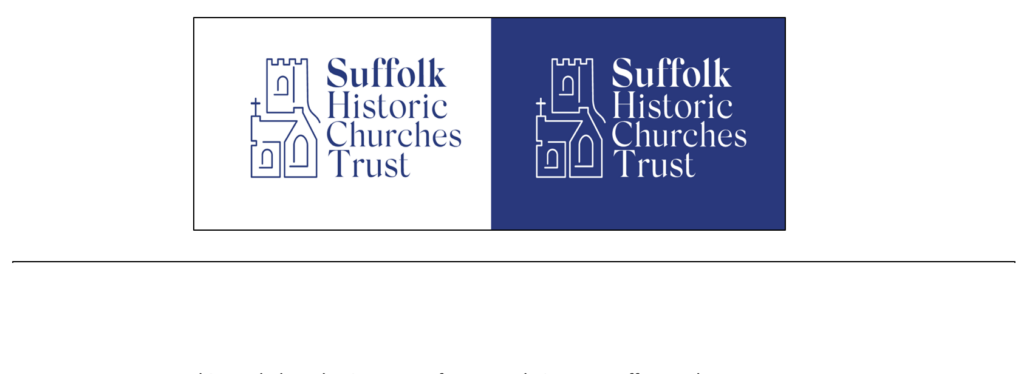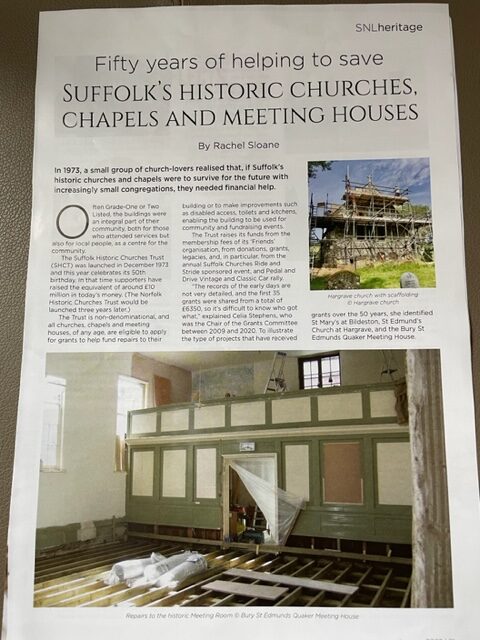50 years of helping Church buildings, Chapels and Meeting Houses


In 1973, a small group of church-lovers realised that, if Suffolk’s historic churches and chapels were to survive for the future with increasingly small congregations, they needed financial help. Often Grade-One or Two Listed, the buildings were an integral part of their community, both for those who attended services but also for local people, as a centre for the community.
The Suffolk Historic Churches Trust (SHCT) was launched in December 1973 and this year celebrates its 50th birthday. In that time supporters have raised the equivalent of around £10 million in today’s money. (The Norfolk Historic Churches Trust would be launched three years later).
The Trust is non-denominational and all churches, chapels and meeting houses, of any age, are eligible to apply for grants to help fund repairs to their building or to make improvements such as disabled access, toilets and kitchens, enabling the building can be used for community and fundraising events.
The Trust raises its funds from the membership fees of its ‘Friends’ organisation, from donations, grants, legacies, and, in particular, from the annual Suffolk Churches Ride and Stride sponsored event, and Pedal and Drive Vintage and Classic Car rally.
“The records of the early days are not very detailed, and the first 35 grants were shared from a total of £6350, so it’s difficult to know who got what,” explained Celia Stephens who was the Chair of the Grants Committee between 2009 and 2020. To illustrate the type of projects that have received grants over the 50 years, she identified St Mary’s at Bildeston, St Edmund’s church at Hargrave, and the Bury St Edmunds Quaker Meeting House.
St Mary’s, at Bildeston, church tower dramatically collapsed in 1975,and was one of the first churches to get a grant from the Trust, being awarded a total of four grants between 1976 and 1990, which amounted to about £6,000.
“Scaffolders’ were working putting up more scaffolding so that a new ring-beam could be put around the tower to hold it together,” explained church warden, Neil Ashwell, “and as they took out some of the old stone, they felt the movement and just got down in time.”
How close did it come to losing the church?
“I think the two church wardens at that time they were determined to have the church rebuilt and usable again. They put some funding together to cap off the top of the tower until they raised the money for the rest of the build. SHCT helped a great deal, and a lot of the balance came from the Lottery Fund. The cost of the current tower was around £375,000 but if we had had it rebuilt in stone it would have cost over £1/2 million. That’s why it went to a wooden rebuild. Today the church is part of the community and very much thought of and looked after.”
St Edmunds church at Hargrave
In late 2014 the cracks on the east wall of the chancel were widening and new ones appearing. The church and community had only just renewed the north roof the year before, and that had cost about £80,000. SHCT had given a grant towards the new roof, but then…
“We had had euphoria for about a year and then the cracks started to show,” explained Peter Reddick, the Fabric Officer for St Edmund’s.
Although the chancel dates from 1240, it was extensively remodelled by the Victorians in 1870 and their remodelled wall rested on footings only 18 inches deep and rainwater drainage disappeared into the clay ground, but went no further than 2 metres with no soak-away.
After extensive monitoring of the cracks at the beginning of 2018, it was time for remedial work to save the wall from collapsing. At the end of year Historic England returned St Edmunds to the “At Risk” Register and fundraising had to begin…
“Because of how bidding works, most of the grant giving bodies ask for 50% money committed before they will consider your application. We were able to fund the investigatory work, but that left us just £7,000 which wasn’t enough for 50%. Celia Stephens from SHCT visited, saw our dilemma and the Trust offered £9,000 which, with one other grant, moved us into the 50% territory. I was then able to go more widely to raise the rest of it. I found other grant bodies really respected the SHCT.”
In autumn 2019 the contractor started the drainage improvement and then underpinning and remedial work could proceed.
“There might be limited numbers coming through the door for services, but we certainly widened our outreach through fundraising and social events and people could see things were happening with the church and were generally supportive.”
The work was completed in 2020 and a full case study can be found on www.shct.org.uk/grants
————————————————————————————————————-
Bury St. Edmunds: Quaker Meeting House
Bury Quaker’s Grade II listed building, with its extensive garden and burial ground, was built by in 1750 and is the oldest Quaker Meeting House in Suffolk that is still in use. Two grants from SHCT were for the repairing the timber frame of the historic building and the second one was for the lime wash rendering of the external walls.
“We recognised we couldn’t go on with piecemeal repair and launched an appeal in 2004 for £500,000 of which we wanted 50% from Quaker sources and 50% from beyond – in the community,” said Mary Pennock, Trustee of Ipswich and District Area Quaker Meetings. “We didn’t want to use Lottery Funding. Urgent repairs to the building were needed but we also needed to bring the community facilities up to 21st century standards, in an environmental way.
“The Trust awarded the Quakers two grants: £7,500 for repair work on external walls and £3,000 for restoration work connected with the new build,” explained Celia Stephens from the SHCT. “We didn’t fund any of the modernisation, as that was not eligible for SHCT funding back in 2005, although we do now give grants towards facilities such as toilets, kitchens, and disabled access,”
Mary remembers how valuable their support was.
“The main thing with the SHCT grant is that it was very generous early on, and it gave us credibility which meant that we could go on to apply for grants outside of Suffolk, particularly from the Churches Trust.”
In 2007 work commenced on the provision of a new room for community meetings, new toilets, and a state-of-the-art kitchen, older rooms had under-floor heating installed and were redecorated. The gallery was re-opened, and a library installed where the old kitchen once was. The work took four years, and the building is now used both by Quakers and the wider community.
——————————————————————————————————
The Suffolk Historic Churches Trust awards grants, of up to £20,000, and the church or chapel must be in regular use as a place of worship, open or easily accessible to the public, and that the rest of the money needed can be raised. Each year the Trust helps between 40 and 50 places of worship of all denominations and ages, also advising churches on other sources of grant aid.
Suffolk Churches Ride and Stride, the annual fundraising day for cyclists, walkers and owners of historic cars, when over 500 churches are open to welcome participants, will take place on Saturday 9th September 2023. Open to all, Ride and Stride attracts walkers and cyclists who are not necessarily church goers, but who appreciate the county and its churches, and enjoy a fun way of raising money for both their local church and for the Trust. The money the Trust raises is then given out as grants to repair church and chapel buildings.
The 50th anniversary of Suffolk Historic Churches Trust will be marked by several special events this year including a service at St Edmundsbury Cathedral, a Summer Garden Party and, as a lasting legacy of the anniversary, the Trust plan to hold two workshops to advise churches on how to set up Church Friends group, that can assist with local fundraising and they also want to create a central database of Suffolk church guide books.
www.shct.org.uk
(This article was first published in Suffolk Norfolk Life magazine January 2023)